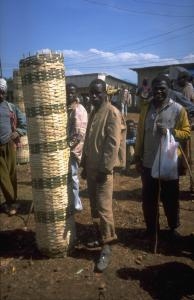Gashaw saw some Mbororo ("Fellata") passing through Muggi seven or eight years ago. There were about 200 men in groups of eight to ten, with lots of cattle. They came from Machaara (Mechara on the map), beyond Dembi Dolo, and went down to the Gambella region (see map 6 and map 7). They stayed in a low-lying area below the small town of Shabal before the checkpoint at the bridge to the west of the road. Other Mbororo came from the opposite direction. Gashaw noticed their pants, which reached below the knee. He also noticed that the Mbororo were tall and "brown" like the Somali and that their cattle were huge. They had loaded some of their belongings on oxen and carried other things on their heads.
Ambissa saw some Mbororo about five years ago. He saw two groups of about 50 persons, including women and children. They were travelling off-road through the forest. Their household items were loaded on donkeys and oxen. They stayed for some time below Shabal, and then turned north-west through the lowlands of an area called Anger.
Market day in Muggi: I have taken photographs of the following: Anfillo selling green pepper; baskets used as bee-hives; longer baskets used for drying coffee; and an Anfillo woman selling seeds of gomen zer (Amh.), a green cabbage. The seeds are used for preparing the pan before baking injera, the ubiquitous flat bread.

|

|

|

|
Move mouse over pictures to see a larger version with captions
Getinet, Ambissa, Gashaw and I go to see an Anfillo activist, whom Ambissa had mentioned during our first encounter with him. This activist, Malaaku, lives half an hour’s walk to the west/north-west. He has given up his plans to achieve a special political status for the Anfillo but is still interested in their social life and history and would welcome more research on these matters.

Ambissa, Günther and Malaaku
Move mouse over picture for larger version
At first, Malaaku was mistrustful of Getinet, whom he identified as an Oromo. He said he would not talk to us if we had a tape-recorder, even though we did not have one with us and had not even addressed the issue. He thinks that he would be persecuted again, if he was suspected of politicising the Anfillo ethnic identity.
He has been to Asosa recently, and I ask him about the northern Mao. He says that he was also curious about them at one point and wanted to include them in his Anfillo movement. But he found out that they were quite different in language and culture. Recently, they have undergone a language shift to Sudan Arabic rather than Oromo, but even their earlier language was different from that of the Mao of Anfillo. This confirms statements made by Grottanelli (1940). Regarding the children given away in lieu of tax payments (see also interview of Harme Eshetu above, entry from November 2001, 17), Malaaku says that children were, indeed, given away in this fashion. But they were assimilated into the societies that they ended up in and have nothing to do with the original northern Mao.
Malaaku attended school for 11 years, which was one year less than he needed for the completion of Secondary School. (His English, however, is poor and we speak with him in Oromo.) His father was too poor to continue financing his education. He looked for employment in vain. The way he tells this implies that the Anfillo are victims of discrimination. He has never had regular employment and became a farmer. In the Derg period, when Shabal and Muggi belonged to the Gambella Region, he was a political representative of the ruling party (WPE: Workers’ Party of Ethiopia) of his area.
In 1995 he spent two weeks in prison. He was accused by the OPDO of ethnic separatism. He said that, under the Derg, he had raised the same issue – recognition of the Anfillo as an ethnic group – without being imprisoned for it. So how can it be, he asks, that now, under the democratic government, one is imprisoned for such a thing? He finally had a chance to speak with the Tigray advisor of the OPDO government in person, and he talked to him in this way. It was on the latter’s initiative that he was released.
Malaaku’s wife, who is very light skinned, is Leqa Oromo (Gidami), i.e., a resettler from north-western Wollega. Malaaku wants to teach his children at least some words of Mao.
Recent research on the Mao language was carried out in 1987 by Gabre Bizunnah and in 2000 by Amanuel Alamayu, both from Addis Ababa University. Malaaku himself intends to prepare a dictionary and has already collected 2,400 words.

|

|
Move mouse over pictures to see a larger version with captions
